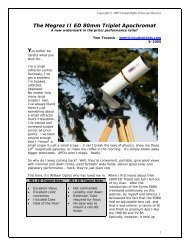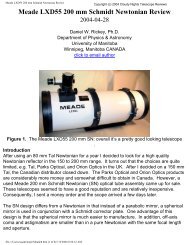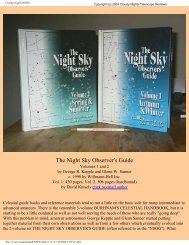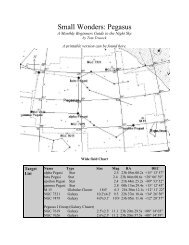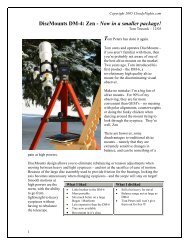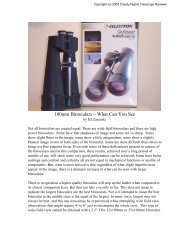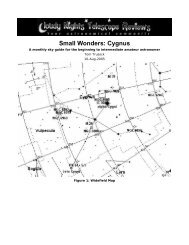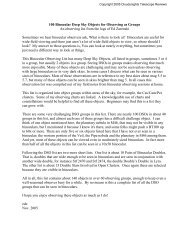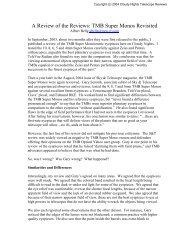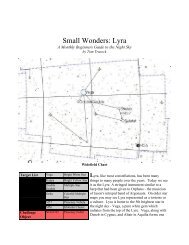CN: Behind the Scenes OMI - Optical Mechanics Inc. - Cloudy Nights
CN: Behind the Scenes OMI - Optical Mechanics Inc. - Cloudy Nights
CN: Behind the Scenes OMI - Optical Mechanics Inc. - Cloudy Nights
You also want an ePaper? Increase the reach of your titles
YUMPU automatically turns print PDFs into web optimized ePapers that Google loves.
1<br />
<strong>CN</strong>: <strong>Behind</strong> <strong>the</strong> <strong>Scenes</strong><br />
<strong>OMI</strong> - <strong>Optical</strong> <strong>Mechanics</strong> <strong>Inc</strong>.<br />
James Mulherin - Owner <strong>OMI</strong> / Torus<br />
Copyright 2005 <strong>Cloudy</strong><strong>Nights</strong>.com<br />
Here at <strong>CN</strong>, we realize that many of our readers are equipment junkies, but sometimes<br />
it's nice to get a glimpse into <strong>the</strong> people and <strong>the</strong> company behind <strong>the</strong> equipment. With this<br />
in mind, we've decided to launch a new series of articles spot lighting and interviewing<br />
some of <strong>the</strong> better known manufacturers for <strong>the</strong> amateur astronomy community. Think of<br />
this as a chance to get to know <strong>the</strong> people who make your favorite toys.<br />
This month in <strong>Behind</strong> <strong>the</strong> <strong>Scenes</strong> we're thrilled to interview James Mulherin <strong>the</strong> owner,<br />
head optician and founder of <strong>Optical</strong> <strong>Mechanics</strong> <strong>Inc</strong>. <strong>Optical</strong> <strong>Mechanics</strong> is a large<br />
supplier of top-of-<strong>the</strong> line mirrors for <strong>the</strong> amateur community and one of <strong>the</strong> major<br />
suppliers of primary mirrors for Obsession Telescopes. James, his wife Stasi and <strong>the</strong>ir<br />
three children Porsche (19), Gabe (18) and Chris are residents of Iowa City, Iowa.<br />
Hi James, and welcome. Thanks for taking <strong>the</strong> time to visit with us today. I guess<br />
our readers would probably like to hear a little bit of your background and how you<br />
got started making mirrors. I know I would. How long have you been active in<br />
astronomy?<br />
Growing up I always had a strong interest in science in general and a mild interest in<br />
astronomy. The interest in astronomy peaked when I took my one and only course in<br />
astronomy at <strong>the</strong> University of Iowa. I studied Physics at <strong>the</strong> U of I, mainly because I<br />
couldn't decide what field of science I wanted to specialize in. I figured with Physics I<br />
would get <strong>the</strong> most general coverage of <strong>the</strong> various fields, <strong>the</strong>n I would specialize in<br />
graduate school. I finally got around to taking <strong>the</strong> astronomy class during <strong>the</strong> second<br />
semester of my Junior year. Part way through <strong>the</strong> course I realized I was having a lot fun.
2<br />
Copyright 2005 <strong>Cloudy</strong><strong>Nights</strong>.com<br />
It was <strong>the</strong>n that I realized how incredibly interesting astronomy is, both for <strong>the</strong> science<br />
and <strong>the</strong> history of <strong>the</strong> subject.<br />
I've been active in astronomy since 1989. With <strong>the</strong> astronomy course at <strong>the</strong> U of I <strong>the</strong>re<br />
was a lab component that met one evening per week. On cloudy nights we did our labs<br />
with canned data from <strong>the</strong> lab manual. On clear nights we were supposed to use <strong>the</strong><br />
telescopes on <strong>the</strong> roof of Van Allen Hall. Well, as luck would have it, we never got a<br />
clear night during labs. I had an intense desire to get a look through a telescope so I<br />
hooked up with a couple of local amateurs to finally see what things look like through an<br />
eyepiece. That's where <strong>the</strong> interest in amateur telescope making took root. After my first<br />
real observing session with an 8" Dob I had to have a scope of my own.<br />
As soon as I realized that you could make your own mirror with no special tools or<br />
machines <strong>the</strong> optics fire was lit. I was completely fascinated by <strong>the</strong> idea of making<br />
something so precise by hand. And that you could see and measure details as small as a<br />
few millionths of an inch with a light source and a knife edge; to me that was<br />
mesmerizing. Finally, that piece of glass that you made by hand would produce images of<br />
those exquisite astronomical objects. It was just too much to bear. I had to make <strong>the</strong><br />
mirror myself.<br />
I bought all of <strong>the</strong> requisite supplies and some books on mirror and telescope making. I<br />
also enrolled in <strong>the</strong> optics course at <strong>the</strong> U of I <strong>the</strong> very next semester. As soon as my<br />
supplies arrived I went to work in my spare time. My first mirror was an 8" F/4. It took<br />
me about 6 months to make it and <strong>the</strong> process turned <strong>the</strong> whole house into a makeshift<br />
optics shop. The operation went from a night stand that I walked around in <strong>the</strong> bedroom<br />
to a 50 gallon drum in <strong>the</strong> kitchen. The hallway of <strong>the</strong> mobile home where Stasi and I<br />
lived at <strong>the</strong> time was my test tunnel. Eventually I built a small machine that consumed<br />
most of <strong>the</strong> bathroom.<br />
I've yet to make a mirror, but know several who have - <strong>the</strong>y tend to relate similar<br />
experiences - but <strong>the</strong>y've never sold commercially, nor are did <strong>the</strong>y become head of<br />
an Optics company! How did you manage to make <strong>the</strong> leap?<br />
After making my first mirror I had all this makeshift equipment and <strong>the</strong> desire to keep<br />
going. I made some small mirrors for local friends and ATMs, tried some different<br />
optical designs like <strong>the</strong> Yolo and Cassegrain, etc. Being a college student with a family,<br />
<strong>the</strong> extra income was kind of nice. Eventually <strong>the</strong> little light bulb went on. Could this be a<br />
career opportunity?<br />
Because of my interest in ATMing I had a subscription to Amateur Telescope Making<br />
Journal. Shortly after I graduated from <strong>the</strong> U of I, I thought "What <strong>the</strong> heck. I'll put an ad<br />
in ATMJ and see what happens¨. I figured I'd sell a few mirrors here and <strong>the</strong>re to<br />
supplement my income from my teaching assistantship position at <strong>the</strong> U of I. Well, I did<br />
sell some mirrors. Enough to convince me that making a full time go of it was worth a<br />
shot. So I left <strong>the</strong> Physics program to pursue <strong>the</strong> optics business full time. Like I said<br />
before, I was in Physics because I couldn't decide what field to specialize in. What I
3<br />
Copyright 2005 <strong>Cloudy</strong><strong>Nights</strong>.com<br />
realized was that I had finally found my calling. Optics! I started in <strong>the</strong> optics business<br />
straight out of college and have been at it since 1991.<br />
My bro<strong>the</strong>r Toney joined me in 1993 to set up our machine shop. At <strong>the</strong> time he was<br />
already working as a machinist, and I had a request from a customer to build an<br />
observatory scope (a 20¨ Classical Cassegrain). Toney had enough faith in me to make<br />
<strong>the</strong> jump to private business and off we went.<br />
One of our first tough jobs in 1993, a 20¨ Cassegrain for a private observatory, was for a<br />
man named John Jamieson. This was my first F/3 mirror and John and I knew it would be<br />
a challenge. John arranged for me to spend a couple of weeks in training with Bob Goff<br />
of AXE in Tucson. Bob <strong>the</strong>n made a follow up visit to our shop in Iowa City to help get<br />
our interferometer working. When <strong>the</strong> scope was completed we loaded it in a U-Haul and<br />
drove it out to Orcas Island, west of Seattle to install it. The whole job was such an<br />
adventure from start to finish. I truly admire John for giving two rookies a chance and<br />
Bob for sharing so freely of his optical knowledge. Both John and Bob passed away a<br />
couple of years ago.<br />
I can imagine. But I'm sure that wasn't <strong>the</strong> FIRST mirror you sold was it?<br />
My first real customer was an amateur astronomer in Wisconsin. I made him an 8¨ F/5<br />
Dob with a fiberglass tube. We later made him a 14.5¨ truss Dob. Don't tell Dave Kriege,<br />
but we were competitors back in 1994. We built and sold about 10 truss Dobs in <strong>the</strong> 12.5¨<br />
to 24¨ range. Obsession pretty much kicked our butts so we got out of that business.<br />
Ano<strong>the</strong>r happy <strong>OMI</strong> crew member figuring amateur sized mirrors<br />
So where are you now - obviously a lot fur<strong>the</strong>r along than 12 years ago, I'd bet. Tell<br />
us a bit about your product line.<br />
Well, I'll start by saying that our products are probably more diverse than you think. First<br />
of all, we keep optics in production for <strong>the</strong> amateur astronomy community. Most of our<br />
sales in this market are to Obsession Telescopes and direct to ATMs. These mirrors range<br />
in size from 12.5" to 25" aperture. For this market we produce over 100 mirrors per year.
4<br />
Copyright 2005 <strong>Cloudy</strong><strong>Nights</strong>.com<br />
My wife Stasi runs <strong>the</strong> machine that figures 12.5" and 15" mirrors. Dean Carlton figures<br />
most of <strong>the</strong> 18", 20" and 24" mirrors. I do all of <strong>the</strong> testing and call out <strong>the</strong> figuring runs<br />
we use to parabolize <strong>the</strong> mirrors.<br />
An <strong>OMI</strong> telescope being installed in Korea<br />
We also build observatory grade Cassegrain telescopes for <strong>the</strong> university and government<br />
markets. These scopes are fully automated with software and controllers to operate <strong>the</strong><br />
scope, filter wheel, CCD camera, etc as well as <strong>the</strong> telescope enclosure. This system is an<br />
offshoot of a system initially developed for <strong>the</strong> Iowa Robotic Observatory, operated by<br />
<strong>the</strong> University of Iowa. It started as a scope on <strong>the</strong> roof of Van Allen Hall, operated by<br />
students in <strong>the</strong> lab down stairs and evolved into a telescope out in Arizona (of our<br />
construction) that is accessed by about 300 U of I undergrad students per year. We've<br />
continued to develop what was formerly known as OCAAS (Observatory Control and
5<br />
Copyright 2005 <strong>Cloudy</strong><strong>Nights</strong>.com<br />
Astronomical Analysis System), now Talon, and apply it to telescopes of our own design<br />
and construction. We build a couple of <strong>the</strong>se systems per year and install <strong>the</strong>m all over<br />
<strong>the</strong> world. They range in size from 16" to 40" aperture. We also do custom work for<br />
University and government research labs: optics or entire telescopes for things like Lidar<br />
(similar in concept to Radar but with laser energy), infrared imaging and so on.<br />
Installing an <strong>OMI</strong> telescope in <strong>the</strong> tropics.<br />
As you probably guessed, in addition to an optics shop we have a well equipped machine<br />
shop and some engineering expertise.<br />
What percentage of your work goes to Amateurs?<br />
I'd estimate that 50% of our work goes to <strong>the</strong> amateur community so you folks are very<br />
important to us. The rest goes to <strong>the</strong> professional community.
6<br />
A large <strong>OMI</strong> Cassegrain<br />
Copyright 2005 <strong>Cloudy</strong><strong>Nights</strong>.com<br />
What's <strong>the</strong> largest mirror you've made, and how many have you shipped?<br />
The largest mirrors we make on a semi-regular basis are .8 and 1 meter. These are usually<br />
Cassegrain primary mirrors at F/3 and <strong>the</strong>y go into our telescopes. We're currently<br />
making a set of mirrors for Caltech which include a 48" diameter flat and a 40" F/2.5<br />
paraboloid. The 48" flat will be our record. These mirrors are for a UV imaging project at<br />
Caltech. We're supplying <strong>the</strong> optics and <strong>the</strong>y are building <strong>the</strong> hardware and<br />
instrumentation.<br />
As far as total current mirror total goes, I don't have an exact number but it's over 1000 to<br />
<strong>the</strong> amateur astronomy community. The last 500 or so shipped in <strong>the</strong> last three years. A<br />
good percentage of <strong>the</strong>se went into Obsession Telescopes.
7<br />
Checking <strong>the</strong> mirror's progress<br />
Copyright 2005 <strong>Cloudy</strong><strong>Nights</strong>.com<br />
I know this is like asking a renaissance master whose style of painting he prefers,<br />
but I'm sure <strong>the</strong>re are a lot of readers out <strong>the</strong>re wondering - What's <strong>the</strong> best way for<br />
someone to compare mirrors from different companies?<br />
A good mirror has <strong>the</strong> following traits: good correction for spherical aberration, a smooth<br />
surface and a good edge (no TDE). We use an interferometer <strong>the</strong> measure <strong>the</strong> mirror's<br />
correction for spherical aberration (among o<strong>the</strong>r among o<strong>the</strong>r optical errors). This is<br />
where <strong>the</strong> quantitative results for our mirrors are generated i.e. <strong>the</strong> Peak to Valley (P-V)<br />
and RMS wavefront errors and <strong>the</strong> Strehl ratio. The o<strong>the</strong>r two, smoothness and edge<br />
quality are more qualitative features of a mirror (but very important none<strong>the</strong>less) and <strong>the</strong>y<br />
are checked using <strong>the</strong> Ronchi test and <strong>the</strong> Foucault knife edge test.<br />
Each of <strong>the</strong> three tests we use has its strengths and weaknesses. I think it's important to<br />
use each of <strong>the</strong> tests where its strengths come through. We use <strong>the</strong> combination of<br />
quantitative (interferometry) and qualitative (Ronchi and Foucault) tests to qualify a<br />
mirror.
8<br />
Testing equipment<br />
Copyright 2005 <strong>Cloudy</strong><strong>Nights</strong>.com<br />
We post a Ronchigram, interferogram and <strong>the</strong> P-V, RMS and Strehl for each Newtonian<br />
mirror we make to our web site. The Ronchigram shows <strong>the</strong> quality of <strong>the</strong> mirror's edge<br />
and surface smoothness. The interferogram and numerical results give you <strong>the</strong><br />
quantitative measures (P-V, RMS and Strehl) as well as a wavefront contour. I know of a<br />
few mirror makers who do something similar so you could visit <strong>the</strong>ir web sites to<br />
compare results.<br />
A quick comment on <strong>the</strong> numbers: when comparing numbers, it's important to know how<br />
<strong>the</strong>y were generated. In most cases <strong>the</strong>y come from interferometry or <strong>the</strong> zonal Foucault<br />
test. There's an important difference between <strong>the</strong> RMS and Strehl ratios calculated by<br />
zonal Foucault testing and interferometric testing. The Foucault test measures a few<br />
points across one diameter of <strong>the</strong> mirror to generate a 2-dimensional cross section of <strong>the</strong><br />
mirror's wavefront. The RMS and Strehl calculations assume that <strong>the</strong> mirror has perfect<br />
rotational symmetry. Because of this assumption RMS and Strehl based on Foucault test<br />
data are always over optimistic.<br />
The interferometer takes data points over <strong>the</strong> entire wavefront and uses <strong>the</strong>m to generate<br />
a 3-dimensional representation of <strong>the</strong> mirror's wavefront. Each interferogram contains<br />
roughly 300 data points from which <strong>the</strong> RMS and Strehl are calculated. We average at<br />
least five interferograms to produce <strong>the</strong> final results for a mirror so you have roughly<br />
1500 data points in <strong>the</strong> calculation.<br />
You can make an excellent mirror using ei<strong>the</strong>r of <strong>the</strong> quantitative test methods,<br />
interferometry or Foucault. It's just that <strong>the</strong> numbers will be a little different in <strong>the</strong> end<br />
and I think people should be aware of this when comparing. Of course, as mentioned<br />
above, <strong>the</strong> numbers are only part of <strong>the</strong> package. A good mirror should be well corrected,<br />
smooth and have an excellent edge (no TDE). If a mirror meets <strong>the</strong>se basic criteria and<br />
has a true Strehl above .80 (or an RMS wavefront error below about .07) it will be an<br />
excellent performer.
9<br />
Copyright 2005 <strong>Cloudy</strong><strong>Nights</strong>.com<br />
Ano<strong>the</strong>r big question many purchasers have when <strong>the</strong>y go to get a premium mirror<br />
is always about <strong>the</strong> coatings - and <strong>the</strong>re's been a lot of debate specifically about<br />
enhanced. I'm curious as to what kind of coatings you personally recommend?<br />
We use enhanced aluminum coatings on all of our mirrors. There's been a lot of debate<br />
over <strong>the</strong> subject of enhanced vs. standard aluminum coatings but I think any side by side<br />
comparison will show that both types of coating are fine with <strong>the</strong> exception that <strong>the</strong><br />
enhanced is brighter. I've read a couple of reviews that compared like apertures, one with<br />
standard aluminum and one with enhanced aluminum and this was what was found in <strong>the</strong><br />
comparison. I think you co-authored one of <strong>the</strong>m.<br />
I'm not a coating expert but I have learned a lot about coatings and <strong>the</strong> coating process in<br />
<strong>the</strong> last few years. Regardless of coating type it's important that <strong>the</strong> process be done<br />
properly. You can screw up a standard coating just as well as you can an enhanced<br />
coating. The process is basically <strong>the</strong> same ei<strong>the</strong>r way but <strong>the</strong> enhanced coating has more<br />
overcoat layers on top of <strong>the</strong> aluminum.<br />
For coatings, we use Flabeg in Pennsylvania. They do a lot of coatings for <strong>the</strong> automotive<br />
industry (rear view mirrors and such) but <strong>the</strong>y also coat large aperture mirrors for<br />
professional observatories.<br />
What does <strong>the</strong> future hold for <strong>OMI</strong>?<br />
In <strong>the</strong> short term much of our energy will go into process refinement and fur<strong>the</strong>r<br />
improving our QC processes. I'm a real hands on kind of guy so I do a lot of<br />
experimenting with different process and test setups. I'll get something working in a<br />
prototypical sort of way and use it for a while to get some work out <strong>the</strong> door. There are<br />
lots of <strong>the</strong> prototypical things still in use throughout <strong>the</strong> shop. We'll revisit <strong>the</strong>se one at a<br />
time to design and build something more refined. Once you have a good process working<br />
most of your energy goes into refinement making it more efficient.<br />
I have some longer range visions that include some vertical integration. Adding things<br />
like glass machining capabilities and coatings. I have a grander vision of building a shop<br />
in a good dark location away from <strong>the</strong> lights and activity of <strong>the</strong> typical light-industrial<br />
zone. I'm looking into it now but its at least a couple of years down <strong>the</strong> road.<br />
We've talked about <strong>OMI</strong> so,lets turn <strong>the</strong> tables a bit - Who do YOU admire in <strong>the</strong><br />
astro community?<br />
I have to give Dave Kriege at Obsession alot of credit. It's partly because of Dave that we<br />
have <strong>the</strong> production process working so well. Without <strong>the</strong> opportunity to make <strong>the</strong><br />
mirrors in some quantity I think our process might look a lot different. In <strong>the</strong> beginning<br />
we had some misfires but Dave stuck with us while we worked out <strong>the</strong> bugs. That takes<br />
guts. I jokingly tell people that Dave is my best friend because he buys so many mirrors<br />
from us. I genuinely like Dave and it's a privilege working with him. Dave's had such a<br />
great impact on amateur astronomy. He's put a lot of large aperture Dobs into <strong>the</strong> hands
10<br />
Copyright 2005 <strong>Cloudy</strong><strong>Nights</strong>.com<br />
of amateurs. I'm really proud of our association with Dave and Obsession. He makes a<br />
great scope and I couldn't think of a better home for one of our mirrors.<br />
James Mulherin, Don Wyman, Dave Kriege and John Crilly<br />
Umm - that particular Obsession looks a little familiar... I will admit, I'm very<br />
pleased with it - and <strong>the</strong> <strong>OMI</strong>/Torus mirror it houses. I've not met Dave in person<br />
yet, but he's invited me to several get toge<strong>the</strong>rs - I do hope to get toge<strong>the</strong>r with him<br />
(and you) at sometime in <strong>the</strong> future at some star party - small or large. I guess that<br />
leads into <strong>the</strong> next logical question - Do you consider yourself a hardcore amateur<br />
astronomer?<br />
I'm an amateur astronomer, but not a very good one. I spend most of my time on business<br />
stuff. The wheels are always turning. Like <strong>the</strong> old saying goes: "The cobbler's kids have<br />
no shoes." I don't get out observing much but I have plans to remedy that. I attended<br />
Astrofest and <strong>the</strong> Okie-Tex Star party this year. I'm signed up for this year's Winter Star<br />
Party too. I've had a good time this year hanging out with Dave Kriege of Obsession<br />
telescopes and our mutual customers.<br />
When I do observe I have a 15" Obsession that suits me just fine. I like it for it's size and<br />
portability and it has plenty of aperture for my casual observing style. Since I don't get<br />
out much I haven't developed any sort of serious observing program, or strong interest in<br />
any particular class of objects. There'll be time for that after I retire in about 25 years In<br />
<strong>the</strong> 15" F/4.5 Obsession my favorite object is <strong>the</strong> Andromeda Galaxy in a 35mm<br />
Panoptic. It's just <strong>the</strong> perfect combination to frame Andromeda and it's companions.<br />
O<strong>the</strong>rwise, I enjoy <strong>the</strong> Messier objects and <strong>the</strong> brighter NGCs, and of course <strong>the</strong> planets. I<br />
even look at <strong>the</strong> moon once in a while. (Apologies to Don Wyman for this bit of heresy.)<br />
I think that's about it for me James, anything else you'd like to comment on?<br />
Our mission is to make our customers happy. That's what makes our business thrive.<br />
Quality, price, delivery, support. Ask anyone at our shop and <strong>the</strong>y will know exactly what<br />
<strong>the</strong>se four words mean to us. We talk about <strong>the</strong>m all <strong>the</strong> time. As a company we believe<br />
that following some basic principles will help us win and keep customers. We are always
11<br />
Copyright 2005 <strong>Cloudy</strong><strong>Nights</strong>.com<br />
working on refinements to our production and QC processes. The goal is to produce<br />
consistent quality, improve efficiency and shorten delivery times. Customer support and<br />
service, before and after <strong>the</strong> sale are also critical. I am extremely accessible. If you call<br />
you usually get me on <strong>the</strong> phone or someone will bring me <strong>the</strong> phone. If I'm at <strong>the</strong> shop<br />
you can talk to me. If I'm not <strong>the</strong>re you'll get a call back within 24 hours. I check and<br />
answer my E-mail at least twice a day. I even participate in <strong>the</strong> some of <strong>the</strong> internet news<br />
groups. I am an aggressive customer supporter, for lack of a better term.<br />
Growing a business is a lot of work but when you get it right it's really rewarding. I'm<br />
frequently told that we have <strong>the</strong> most responsive customer service in <strong>the</strong> business. It's<br />
really nice to hear this because we do work hard at it. It feels good when you get it right.<br />
Thanks James, we appreciate you taking time out of your busy schedule to sit down<br />
with us today.<br />
You're most welcome. I appreciate your giving me a chance to introduce myself and our<br />
company to your readers. I'd like to invite your readers to contact me directly if <strong>the</strong>y have<br />
questions about our products. You can find my direct E-mail and telephone number on<br />
our web site www.opticalmechanics.com. You can also join us on <strong>the</strong> Torusmirror Yohoo<br />
group http://groups.yahoo.com/group/Torusmirrorgroup/<br />
All Pictures Courtesy <strong>OMI</strong>.<br />
Readers: Got a question you'd like to ask your favorite manufacturer? Submit it to:<br />
tomt@cloudynights.com Please include <strong>the</strong> question, and indicate if <strong>the</strong> question is<br />
manufacturer specific. If so, please indicate <strong>the</strong> manufacturer you'd like to see answer <strong>the</strong><br />
question. Please put Suggestions:<strong>Behind</strong> <strong>the</strong> <strong>Scenes</strong> in your subject line.<br />
Vendors / Manufacturers: Would you like to be included in <strong>Behind</strong> <strong>the</strong> <strong>Scenes</strong>? Please
12<br />
Copyright 2005 <strong>Cloudy</strong><strong>Nights</strong>.com<br />
contact: tomt@cloudynights.com for consideration. Please put VENDOR: <strong>Behind</strong> <strong>the</strong><br />
<strong>Scenes</strong> in your subject line.<br />
Article Author: Tom Trusock



